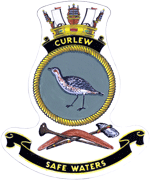HMAS Curlew
| Career (United Kingdom) | |
|---|---|
| Name: | Chediston |
| Builder: | Montrose Shipyard, Scotland |
| Launched: | 6 October 1953 |
| Commissioned: | 28 September 1954 |
| Fate: | Sold to Australia |
| Career (Australia) | |
| Name: | Curlew |
| Acquired: | 1961 |
| Commissioned: | 12 August 1962 |
| Decommissioned: | 30 April 1990 |
| Honours and awards: |
Battle honours: Malaysia 1964–66 |
| Fate: | Sold on 17 June 1991 |
| Badge: |
 |
| General characteristics | |
| Class and type: | Ton class minesweeper |
| Displacement: | 440 tons |
| Length: | 152 ft (46 m) |
| Beam: | 28 ft (8.5 m) |
| Draught: | 8 ft (2.4 m) |
| Propulsion: | Originally Mirrlees diesel, later Napier Deltic, producing 3,000 shp (2,200 kW) on each of two shafts |
| Speed: | 15 knots (28 km/h; 17 mph) |
| Complement: | 33 |
| Armament: | 1 × Bofors 40 mm gun 1 × Oerlikon 20 mm cannon 1 × M2 Browning machine gun |
HMAS Curlew (M 1121) was a Ton class minesweeper operated by the Royal Navy (as HMS Chediston) from 1953 to 1961, and the Royal Australian Navy from 1962 to 1991. During her Australian service, the ship operated off Malaysia during the Indonesia–Malaysia confrontation during the mid-1960s, then was modified for use as a minehunter. Delays in bringing a replacement class into service kept Curlew operational until 1990, and she was sold into civilian service in 1991.
Construction
The minesweeper was built by the Montrose Shipyard in Scotland, launched on 6 October 1953, and commissioned into the Royal Navy on 28 September 1954 as HMS Chediston.[1]
Operational history
Royal Navy
Between August 1955 and October 1957, the ship was attached to Tay Division of the Royal Naval Volunteer Reserve.[1] After October 1957, the ship was placed in storage.[1]
Royal Australian Navy
The ship was one of six sold to the Royal Australian Navy for A£5.5 million in 1961.[2] Chediston was modified for tropical conditions, and commissioned on 12 August 1962 as HMAS Curlew.[1][2]
During the mid-1960s, Curlew was one of several ships operating in support of the Malaysian government during the Indonesia-Malaysia Confrontation. This service was later recognised with the battle honour "Malaysia 1964–66".[3][4]
In the late 1960s, Curlew and sister ship Snipe were modified for use as minehunters.[5]
Divers from Curlew inspected the wreck of Japanese submarine I-124.[6]
Decommissioning and fate
The delay in bringing the Bay class minehunters into service kept Curlew operational until 2001.[5] Curlew paid off on 30 April 1990 and was sold on 17 June 1991.[1] As of mid-2003, the ship was operating out of Port Huon, Tasmania as a fishing vessel.[7]
Citations
- ↑ 1.0 1.1 1.2 1.3 1.4 Royal Australian Navy, HMAS Curlew
- ↑ 2.0 2.1 Spurling, in Stevens, The Royal Australian Navy, p. 189
- ↑ "Navy Marks 109th Birthday With Historic Changes To Battle Honours". Royal Australian Navy. 1 March 2010. Archived from the original on 13 June 2011. Retrieved 23 December 2012.
- ↑ "Royal Australian Navy Ship/Unit Battle Honours" (PDF). Royal Australian Navy. 1 March 2010. Archived from the original (PDF) on 14 June 2011. Retrieved 23 December 2012.
- ↑ 5.0 5.1 Jones, in Stevens, The Royal Australian Navy, p. 222
- ↑ Fulton, The Fujita Plan
- ↑ Australian Sea Heritage, Old ships find a new life
References
- Books
- Felton, Mark (7 December 2006). The Fujita Plan. Pen and Sword. ISBN 1473819334. Retrieved 20 August 2014.
- Stevens, David, ed. (2001). The Royal Australian Navy. The Australian Centenary History of Defence (vol III). South Melbourne, VIC: Oxford University Press. ISBN 0-19-555542-2. OCLC 50418095.
- Jones, Peter. "Towards Self Reliance". The Royal Australian Navy.
- Spurling, Kathryn. "The Era of Defence Reform". The Royal Australian Navy.
- Journal articles
- "Old ships find a new life". Australian Sea Heritage (Australian Heritage Fleet) (75): 6. Winter 2003. ISSN 0813-0523.
- Websites
- "HMAS Curlew". Royal Australian Navy. Retrieved 20 August 2014.
| ||||||||||||||||||||||||||||||||||||||